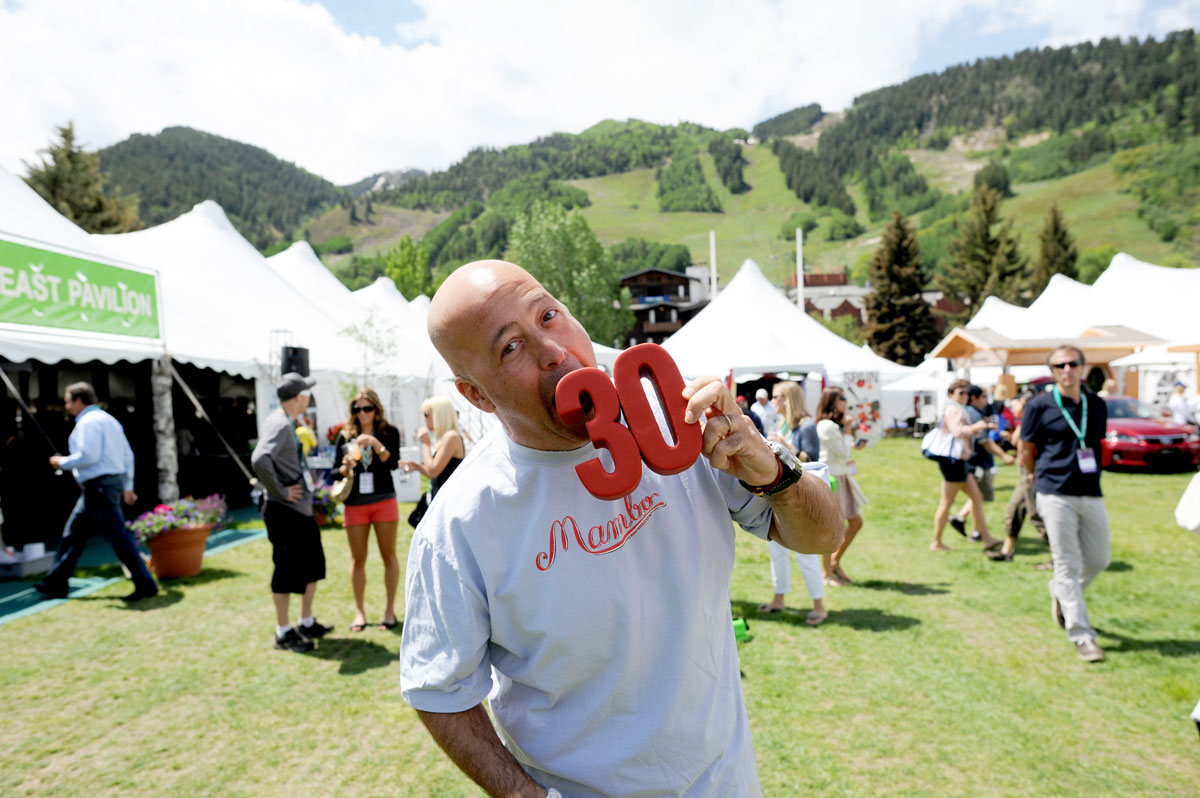Soups to Nuts: Andrew Zimmern Cooks—and Eats—It All
Andrew Zimmern is a James Beard Award–winning television personality, chef and food writer, perhaps best known for his Travel Channel series “Bizarre Foods.” At the 2012 Food & Wine Classic in Aspen, Zimmern hosted a cooking seminar featuring wild meat, called “Game On.”
Amiee White Beazley, previous editor of edibleASPEN, had a chance to chat with Zimmern about his favorite eats and food traditions.
edibleASPEN: You’ve been around the world several times. Is there a food out there that you haven’t tried that you’d like to get your fingers on?
Andrew Zimmern: There are always unicorns and elves. And I understand that Bourdain is eating a Tooth Fairy on an upcoming episode, so I missed the boat on that one.
eA: What excites you about regional food in Western Colorado?
AZ: The direct pipeline is short. Trout is in water, then in pan. Elk is grazing, then on grill. There is also a relevant simplicity to the food scene that I like, and the Mexican food influence is also sharply felt. I love the small-town diners in places where the Sysco truck doesn’t go all the time. Good honest grub.
eA: Is there a particular dish that you remember and look forward to in Aspen?
AZ: Anything at Ajax Tavern. I always love the food there. The restaurant scene in Aspen is superb; like most resort towns, it’s the consistency that needs work. Campo de Fiore, Matsuhisa, Pinons, Syzygy, Kenichi are all fun. Mezzaluna too. Some of those places I have dined in for almost two decades! I remember the pizza and burgers at Pinocchio’s in Aspen in 1975, so I have a long history in that town.
eA: This year marks the 30th anniversary of the Food & Wine Classic at Aspen. Tell me about your experience at the Classic, and what will attendees learn at your seminar “Game On”?
AZ: I have been to the last three, presented at the last two and attended my first 24 years ago. It’s the greatest food getaway I know of in the USA, and to be able to spend time in the mountains in summer is thrilling. The first few times I attended I was a line cook, working in restaurants that were overloaded hosting dinners, and trying to max out their business that week. I flew in to help friends in their kitchens or with demos and then we would steal tickets and go to parties. I wasn’t a rules-playing kind of young man.
My demos will show people that alternative proteins like wild game are a year-round food, taste good, are healthier for you, are cheaper, support sustainability across all platforms, fight flavor fatigue, are simple to make and do more to change our food system for the better than choosing commoditized cheap proteins from factory farms.
eA: How does eating the world change how you look at food every day in your own home? For example, do you make your kids simple meals like PB & J?
AZ: Of course, and I eat them too. We just spread our choices out in a broader spectrum, which is better for our planet than recycling newspapers and sitting on your couch thinking you have helped your planet out. Don’t get me wrong, I am all for recycling, but that’s a bare minimum expectation for citizenship. I think we owe it to our next generation to wean them off the commoditized-food teat.
eA: In this issue of edibleASPEN, we have a story about “cowboy caviar,” aka Rocky Mountain oysters, aka bull testicles. Have you ever had them?
AZ: I have eaten the balls of about 42 animals, last time I counted. Steer nuts are good, but 99.9 percent of the time they aren’t fresh. This is a food that you need to take from field to fire very quickly. When that happens I will put them up against any food you care to for an elegant eating discourse. Balls that have been snipped, frozen and thawed, sliced and battered and deep fried is not food, it’s a gimmick. And they taste like a raunchy Tater Tot at that point. Worthless. If you have them fresh, peeled and sautéed over high heat from a wood fire in a cast-iron skillet with hot chiles and some onion, I will come running.
eA: If you were to host an episode of your show “Bizarre Foods America” in Aspen, what do you think you might highlight?
AZ: Some of the wild food parties across the Valley. Crazy stuff gets flown in to the airport on private planes all the time. Obviously some good wild game stories, some foraging stories.
eA: On “Bizarre Foods,” you have eaten just about everything, from bees to sparrows, but stop short at dog, which is served widely in Asia. Why? Is there anything else that you refuse to eat?
AZ: I have tried dog several times and don’t care for it. And it’s not served widely, actually, just very intensely in a few corners of a few countries (Vietnam, Korea to name two). I wouldn’t eat anything endangered or threatened.
eA: There is a belief that globalization is affecting food diversity. How do you recommend keeping food traditions alive in one’s region/hometown?
AZ: It’s not a belief, it’s a fact. Cultural sustainability is crucial; there are whole generations of kids in small towns and big cities all over the world who don’t even recognize what their parents ate as kids. That’s harmful, the world is not one giant McDonapizzakingfriedchikatacobowl! I make my show in part because I want to demonstrate how important those pathways are.
“Cultural sustainability is crucial; there are whole generations of kids in small towns and big cities all over the world who don’t even recognize what their parents ate as kids.” —Andrew Zimmern




